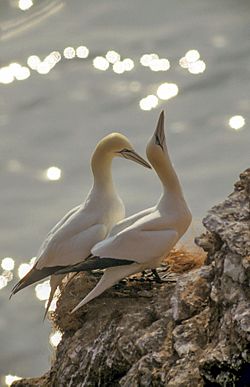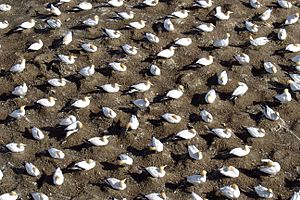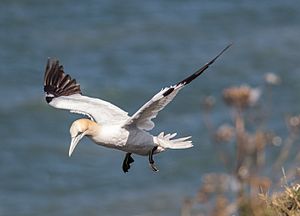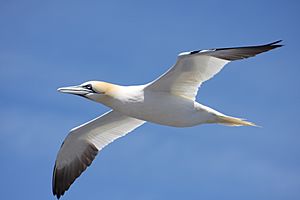Gannet facts for kids
Quick facts for kids Gannet |
|
|---|---|
 |
|
| Northern Gannets on Heligoland, a small German archipelago in the North Sea | |
| Scientific classification | |
| Kingdom: | |
| Phylum: | |
| Class: | |
| Order: | |
| Family: | |
| Genus: |
Morus
Linnaeus, 1753
|
| Species | |
|
|
| Synonyms | |
|
Moris |
|
Gannets are amazing seabirds that belong to the genus Morus. They are related to boobies, which are another type of seabird. Gannets are large birds, usually white and black, with distinctive yellow heads. They have long, pointed wings and strong, pointed bills.
Gannets are known for laying only one blue egg at a time. The Northern gannet is the biggest seabird in the North Atlantic. It can have a wingspan of up to 2 meters (about 6.5 feet)! The other two gannet species live in the warmer seas near southern Africa, southern Australia, and New Zealand.
Hunting and Amazing Dives
Gannets are incredible hunters. They catch fish by diving headfirst into the sea from high up in the air. They then chase their prey underwater. To do this, gannets have some special features:
- They don't have outside nostrils. Instead, their nostrils are located inside their mouth. This stops water from rushing in when they dive.
- They have air sacs in their face and chest, right under their skin. These sacs work like bubble wrapping. They cushion the impact when the gannet hits the water at high speed.
- Their eyes are placed far enough forward on their face. This gives them binocular vision, which means they can judge distances very accurately. This is super important for hitting their target!
Gannets can dive from a height of 30 meters (about 100 feet). They can reach speeds of 100 kilometers per hour (about 60 miles per hour) as they hit the water! This incredible speed allows them to catch fish much deeper than most other birds that hunt from the air. Because gannets can eat a lot of fish, the word "gannet" is sometimes used to describe someone who eats a lot of food.
Mating and Nesting

Gannets are colonial breeders. This means they gather in large groups to nest on islands and along coasts. They usually lay one chalky, blue egg. Interestingly, gannets don't have "brood patches" (bare skin areas that birds use to warm eggs). Instead, they use their large, webbed feet to keep their eggs warm.
It takes about five years for young gannets to become adults. When they are first born, their feathers are completely black. As they get older, they slowly get more and more white feathers until they have their adult plumage.
The United Kingdom is the most important nesting ground for northern gannets. About two-thirds of all northern gannets in the world live there! Many of them are found in Scotland, including the Shetland Isles. Other northern gannets live in Canada, Ireland, the Faroe Islands, and Iceland. Smaller groups are found in France (often seen in the Bay of Biscay), the Channel Islands, Norway, and a single colony in Germany on Heligoland.
The biggest northern gannet colony is on Scotland's Bass Rock. In 2014, this colony had about 75,000 pairs of gannets! Other important breeding spots include Sulasgeir off the Isle of Lewis, St. Kilda, Grassholm in Pembrokeshire, Bempton Cliffs in the East Riding of Yorkshire, Sceilig Bheag in Ireland, and Bonaventure Island in Quebec, Canada.
Gannet Species
There are three main types, or species, of gannets. They are all usually placed in the genus Morus.
- Northern gannet (also called "solan goose"), Morus bassanus
- Cape gannet, Morus capensis
- Australasian gannet, Morus serrator
At one time, people thought all gannet species were just one single species. But now we know there are three distinct ones!
See also
 In Spanish: Alcatraz para niños
In Spanish: Alcatraz para niños




